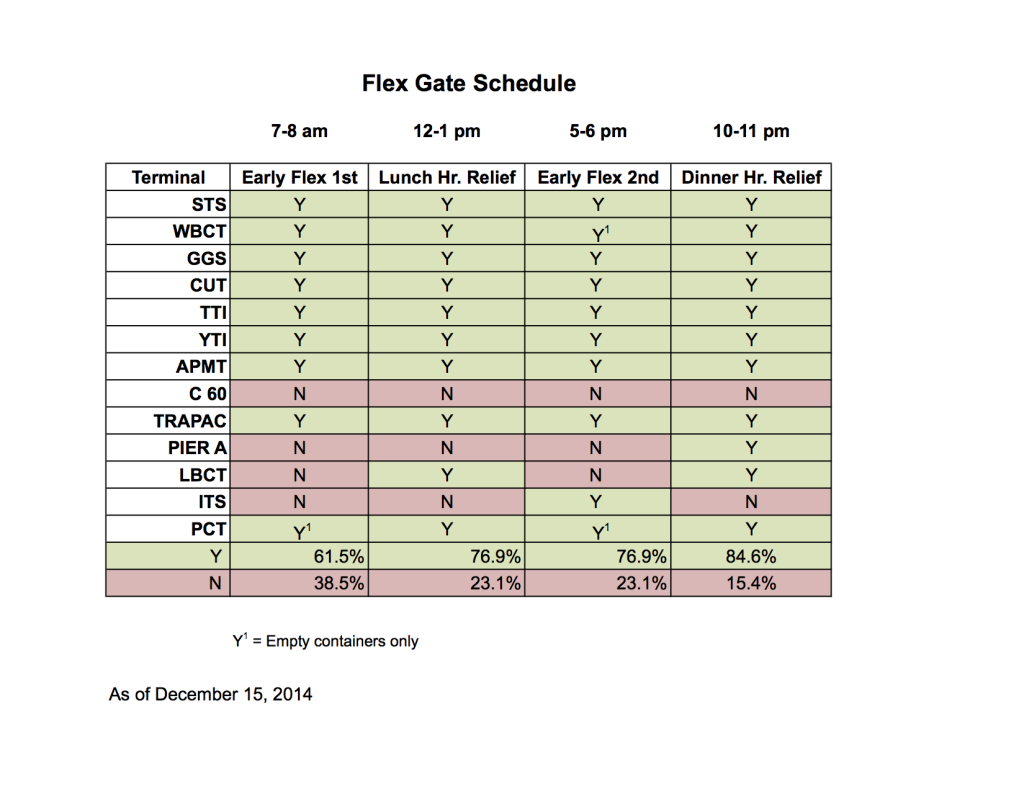LONG BEACH, Calif., Sept. 11, 2014 – PierPass Inc. today launched the Free-Flow Program, testing a new cargo-handling process expected to significantly reduce the time it takes participating trucks to pick up containers at marine terminals.
Today’s random-access process – where any truck can show up at any time to pick up any container – hasn’t changed since containerization began in the early 1960’s. With new, larger ships unloading as many as 5,000 containers at a time, the random-access process is creating efficiency challenges at major ports around the world.
The free-flow process enables bulk delivery of large groups of containers belonging to the same cargo owner, trucking company or logistics company.
“To keep cargo flowing quickly as ships grow ever larger, we need to change how we move containers,” said PierPass President and CEO Bruce Wargo. “Doing the same things incrementally faster won’t solve congestion pressures.”
Mr. Wargo added, “How congested would LAX or JFK be if every taxi came for one specific person rather than picking up the first in line? That’s how the current container cargo system works.”
Under the Free-Flow Program, PierPass is working with participating terminals, trucking companies and cargo owners to test free-flow, measure its impact on cargo velocity and costs, and learn what methods and resources are needed to run free-flow successfully. If the testing demonstrates significantly positive results, free-flow is expected to become a regular part of terminal operations.
In a typical case, a large retailer that has 80 or more containers arriving on a single ship will arrange free-flow delivery with the marine terminal. In other cases, a trucking or logistics company can arrange for free-flow by consolidating groups of containers from multiple cargo owners.
Under the current system, when terminals unload containers from arriving ships they pile them into stacks in the order they come off the ship. When trucks arrive and request a specific container, it has to be located and dug out of a stack that can be four or five containers high and six containers deep. Container-handling equipment like rubber-tired gantry cranes (RTGs) must move an average of three containers to dig a specific container out of the stack and deliver it to a waiting truck. As a result, one RTG can deliver an average of only eight to ten containers per hour. Using the free-flow process, a tophandler crane is expected to deliver as many as 20 containers per hour.
The free-flow process starts when a ship is being unloaded. All containers claimed by a single owner, trucking company or logistics provider are piled into a separate stack. The cargo owner or its representative then sends a stream of trucks into the marine terminal through a special lane, and each truck takes the next container in the stack.
Trial runs of free-flow have shown a range of results and are helping terminal operators and trucking companies learn how to best structure the process. At best, trucking companies have reported turn times as short as 11 minutes, compared to about 45 minutes for a typical transaction.
Terminal operators believe that free-flow might eventually account for as much as 30% of cargo moves. While the trucks participating in free-flow will see the most dramatic improvement, the process should have a spillover benefit to the rest of the trucks, by reducing the number of trucks in the RTG lanes.
“While free-flow isn’t a silver bullet to fix all congestion issues, we believe it can significantly benefit port users,” Mr. Wargo said. “Terminal operators will continue to innovate how they handle growing cargo volumes, to ensure that the Ports of Los Angeles and Long Beach remain the most reliable and productive in North America.”
For additional information about the Free-Flow Program, see Rule 14 in the West Coast MTO Agreement’s Marine Terminal Schedule No. 1, available at http://wcmtoa.org/wp-content/uploads/2014/09/wcmtoa-10-8-schedule.pdf.
About PierPass
PierPass is a not-for-profit company created by marine terminal operators at the Port of Los Angeles and Port of Long Beach in 2005 to address multi-terminal issues such as congestion, air quality and security. To learn what it takes for a truck to drop off or pick up a container at a marine terminal, see http://youtu.be/P9IJN1yIIJ4. For additional information, please see www.pierpass.org.
# # #

